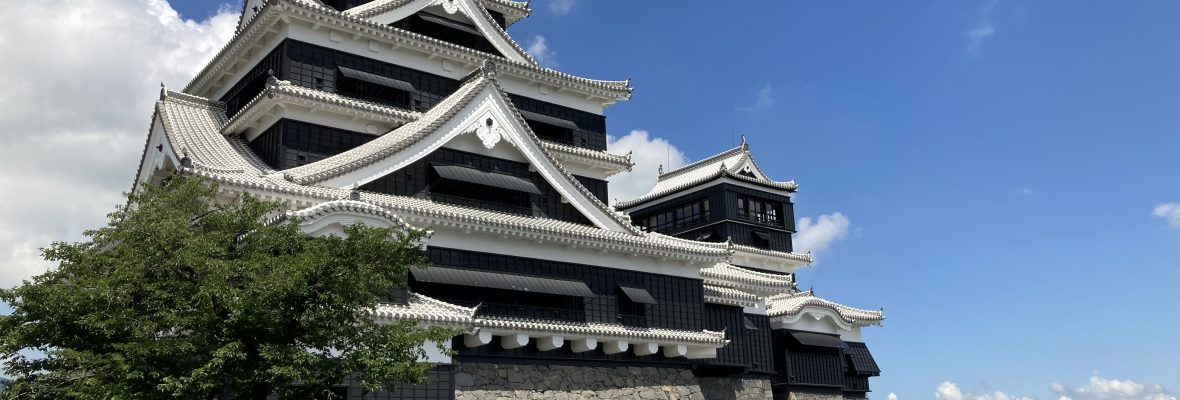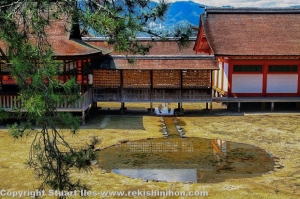This article was originally going to be included in the ‘History of Aki (Hiroshima) Prefecture’ but as this article has now become too long I decided to make one for Miyajima on its own. I was surprised by the fantastic history of this temple complex and I hope you think so too.
Located in the Seto Inland Sea, ten miles (6 km) southwest of the city of Hiroshima, the small island of Miyajima is a sacred site of both Shintoism and Buddhism. Long before Buddhism came to Japan in the 5th century AD, Shinto worshippers lived as hermits in the mountain’s forested hills. The earliest building thought to have been constructed in 593 by Saeki Kuramoto, but the first record of Itsukushima Shrine in Japanese history is found in the Nihon Koki (Notes on Japan), dated 811.
During the era of Taira-no-Kiyomori, the later part of the Heian period (794-1185) it became a place of worship for the Heike clan, and around 1168, the old main shrine building built back in 593 was finally rebuilt as we can see it today. As the power of the Heike clan increased, the number of worshippers at the shrine also increased, the shrine itself began to become known among the members of the Imperial Court, and its grandeur became more and more magnificent.
The emperor and members of the Imperial Court paid visits to the shrine, and the culture of the Heian Period was amiably incorporated. Bugaku, ancient Japanese musical court dance, also began during this period. Even after the fall of the Heike clan, the culture of the Heian Period was warmly accepted by the Genji clan and the shrine continued to experience a stable and prosperous era.
The complex of buildings includes the main shrine, several subsidiary temples, a Noh drama and dance stage, and many bridges and walkways linking the various parts of the temple. Built on tidal land and giving the appearance of floating on the sea during high tide, the Main Shrine is dedicated to the three Munakata goddesses, Ichikishima-hime, Tagitsu-hime and Tagori-hime. After the Meiji Restoration, chigi (ornamental horn-like crossbeams on the gable of a shrine roof) and katsuogi (log-like elements on the ridge of a shrine roof) were added to the Main Shrine, lending to the structure a typical Shinto architectural style. When major repairs were carried out in the Meiji and Taisho eras, however, these architectural elements were removed, and the original style was restored.
Metal nails were not used in the construction of the buildings and there are precisely calculated crevices between the floor slabs to alleviate the pressure of high tidal waves caused by typhoons. Some of the ancient wooden planks used for flooring are 1.5 meters wide and over 10 meters long, and these enormous boards were transported to Miyajima from hundreds of kilometers away in northern Japan. One of the bridges leading to the shrine, built in 1557, is known as the Soribashi or Imperial Envoy’s bridge exclusively used by the court nobles.
Adjacent to the Itsukushima shrine is the Hokoku shrine. An inner part of this shrine, known as the Senjokaku, was constructed by the fabled Japanese warrior Hideyoshi Toyotomi for the repose of the souls of war dead. Parts of the building, such as the ceiling and front entrance, remain unfinished because of Hideyoshi’s death. The five-storied pagoda, 27 meters tall, is believed to have been built in 1407 and represents a harmonious combination of Chinese and Japanese architectural styles. Within the pagoda, painted in full color, is a beautiful image of the Buddha.
The beautiful Otorii gate, standing in the sea and leading to the Itsukushima shrine, is the symbol of Miyajima Island. The original Otorii was built in 1168 and the present Otorii, is the eighth that has been constructed since the Heian period (794-1192), was built in 1875 with the wood of camphor trees. It is 16 meters tall, the roof is 24 meters long, and the main pillars are made from single trees. The Otorii stands on its own support, having no part buried in the ground.
From the Kamakura Period (1185–1333) through to the Sengoku Period (1467-1603) when the political situation was unstable, the shrine’s influence gradually declined and the shrine eventually fell into ruin. However, in 1555 Mori Motonari the Lord of Aki province won an important battle on the island of Itsukushima. After this battle, the Mori clan now had complete control over the western provinces of the Chugoku region and under Mori control the shrine regained the reverence it had before and once again its grandeur was restored.
Written by Stuart Iles. Photos by Rui.





Amazed to read that it stands up by itself without being buried in the ground. With all the winds and typhoons hitting the area, it must be protected by the Gods. Thanks for the read.
LikeLike
Yes agree. Although the Otorii we see today is the 8th one, built in 1875. The first one was built in 1168.
LikeLike
Good read. I thoroughly enjoyed Miyajima island, especially the ferry ride, and Senjokaku pavilion with its magnificent views.
LikeLike
Thankyou Nadir.
LikeLike